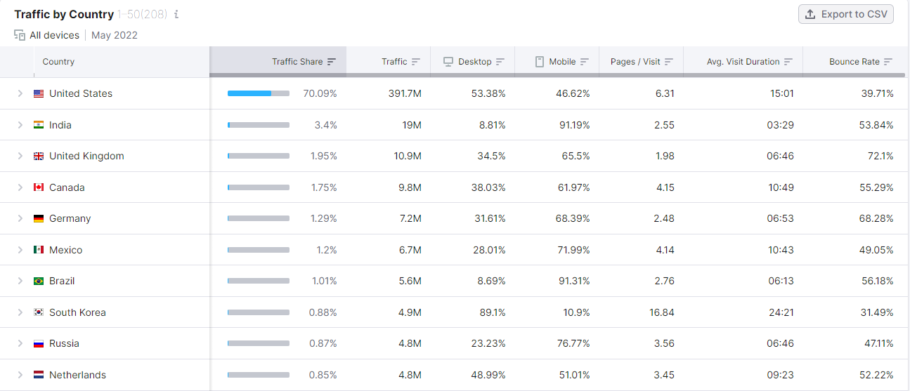Using different types of market segmentation allows you to target customers based on unique characteristics, create more effective marketing campaigns, and find opportunities in your market.
See how you can leverage market segmentation by learning:
- What market segmentation is
- Why market segmentation is important
- The four types of market segmentation
- How to create a market segmentation strategy
What Is Market Segmentation?
Market segmentation is the process of dividing a target market of potential customers into segments with common characteristics. Through a process of audience analysis, segments are composed of consumers who respond similarly to marketing strategies and share traits such as similar interests, needs, or locations.
Marketers often measure their performance at attracting these market segments with KPIs like the share of voice.
Eight Benefits of Market Segmentation
The importance of market segmentation is that it makes it easier to focus marketing efforts and resources on reaching the most valuable audiences and achieving business goals.
Market segmentation allows you to know your customers, identify what is needed in your market segment, and determine how to best meet your product or service needs. This helps you design and execute better marketing strategies from top to bottom.
Market segmentation helps you get to know your customers, identify what's needed in your market segment, and determine how you can best meet those needs with your product or service.Click to tweet1. Create stronger marketing messages
You can develop stronger marketing messages when you know whom you’re talking to. You can avoid generic, vague language that speaks to a broad audience. Instead, you can use direct messaging that speaks to your target audience’s needs, wants, and unique characteristics.
2. Identify the most effective marketing tactics
Knowing what will attract your ideal audience can be difficult with dozens of marketing tactics available. Using different types of market segmentation guides you toward the marketing strategies that will work best. When you know the target audience, you can determine the best solutions and methods for reaching them.
3. Design hyper-targeted ads
You can target audiences by age, location, purchasing habits, interests, and more on digital ad services. When you use market segmentation to define your audience, you know these detailed characteristics and can use them to create more effective, targeted digital ad campaigns.
4. Attract (and convert) quality leads
When your marketing messages are clear, direct, and targeted, they attract the right people. You draw in ideal prospects and are more likely to convert potential customers into buyers.
5. Differentiate your brand from competitors
Being more specific about your value propositions and messaging allows you to stand out from competitors. Instead of blending in with other brands, you can differentiate your brand by focusing on specific customer needs and characteristics.
6. Build deeper customer affinity
When you know what your customers want and need, you can deliver and communicate offerings that uniquely serve and resonate with them.Click to tweetWhen you know what your customers want and need, you can deliver and communicate offerings that uniquely serve and resonate with them. This distinct value and messaging builds stronger bonds between brands and customers and creates lasting brand affinity.
7. Identify niche market opportunities
Niche marketing is identifying segments of industries and verticals with a large audience that can be served in new ways. When you segment your target market, you can find underserved niche markets where you can develop new products and services.
8. Stay focused
Targeting in marketing keeps your messaging and marketing objectives on track. It helps you identify new marketing opportunities and avoid distractions that lead you away from your target market.
The Four Types of Market Segmentation
The four bases of market segmentation are:
- Demographic segmentation
- Psychographic segmentation
- Behavioral segmentation
- Geographic segmentation
Within each market segmentation type, multiple sub-categories further classify audiences and customers.

Demographic Segmentation
Demographic segmentation is one of the most popular and commonly used types of market segmentation. It refers to statistical data about a group of people.
Demographic Market Segmentation Examples
- Age
- Gender
- Income
- Location
- Family Situation
- Annual Income
- Education
- Ethnicity
Where the above examples help segment B2C audiences, a business might use the following to classify a B2B audience:
- Company size
- Industry
- Job function
Because demographic information is statistical and factual, it is usually relatively easy to uncover using various sites for market research.
A simple example of B2C demographic segmentation could be a vehicle manufacturer that sells a luxury car brand (ex. Maserati). This company would likely target an audience that has a higher income.
Another B2B example might be a brand that sells an enterprise marketing platform. This brand would likely target marketing managers at larger companies (ex. 500+ employees) who have the ability to make purchase decisions for their teams.
Psychographic Segmentation
Psychographic segmentation categorizes audiences and customers by factors related to their personalities and characteristics.
Psychographic Market Segmentation Examples
- Personality traits
- Values
- Attitudes
- Interests
- Lifestyles
- Psychological influences
- Subconscious and conscious beliefs
- Motivations
- Priorities
Psychographic segmentation factors are slightly more difficult to identify than demographics because they are subjective. They are not data-focused and require research to uncover and understand.
For example, the luxury car brand may focus on customers who value quality and status. While the B2B enterprise marketing platform may target marketing managers motivated to increase productivity and show value to their executive team.
Behavioral Segmentation
While demographic and psychographic segmentation focuses on who a customer is, behavioral segmentation focuses on how the customer acts.
Behavioral Market Segmentation Examples
- Purchasing habits
- Spending habits
- User status
- Brand interactions
Behavioral segmentation requires you to know about your customer’s actions. These activities may relate to how a customer interacts with your brand or to other activities that happen away from your brand.
A B2C example in this segment may be the luxury car brand targeting customers who have purchased a high-end vehicle in the past three years. The B2B marketing platform may focus on leads who have signed up for one of their free webinars.
Geographic Segmentation
Geographic segmentation is the simplest type of market segmentation. It categorizes customers based on geographic borders.
Geographic Market Segmentation Examples
- ZIP code
- City
- Country
- Radius around a certain location
- Climate
- Urban or rural
Geographic segmentation can refer to a defined geographic boundary (such as a city or ZIP code) or type of area (such as the size of the city or type of climate).
An example of geographic segmentation may be the luxury car company targeting customers who live in warm climates where vehicles don’t need to be equipped for snowy weather. The marketing platform might focus its marketing efforts around urban city centers where its target customer is likely to work.
How to Create a Market Segmentation Strategy
Now, you know what market segmentation is, why it’s important, and the four types of market segmentation. It’s time to put this information into practice.
Use the following market segmentation process to learn about your audience and find new marketing and product opportunities.
1. Analyze your existing customers
If you have existing customers, start your market segmentation by performing an audience analysis. An audience analysis allows you to learn about your customers and begin identifying trends within your current customer base. Use these market research questions to guide your research.
Interview your customers.
Go right to the source and conduct interviews with existing customers, past customers, ideal customers, prospects, and leads. Ask questions that help you fill in the details of all four types of market segmentation.
Interview your sales team.
If you have a sales team that spends a lot of time working with customers, use them as a resource. Interview them to find commonalities or trends they often see while working with your customers.
Refer to your business data.
Your business likely has loads of data that can help you get to know your customers. Use your customer relationship management tools and point-of-sale systems to find trends related to behavioral segmentation. Pull data that shows how much customers spend, how often they visit your store, and the type of products and services they buy.
Use your website analytics.
Your website also has data that can help you learn about your audience. Use Google Analytics to find details related to all four types of market segmentation. For example, you can learn about customer behavior by seeing what pages users visit, how long they stay on the site, and what referral sites led them to your site.
Research audience geography.
Get details for graphic segmentation and find out where your audience lives using tools like Google Analytics or websites you don’t control (for instance, your competitors) you can use Semrush and Ahrefs.
Navigate to Google Analytics \ Geo \ Location to overview the visitors’ countries in a given period. You can also research the audience based on City, Continent, Sub-continent, or Language.

On the other hand, if you don’t have access to the website’s traffic analytics, you can use tools like Semrush or Ahrefs. Enter your site URL, and the report shows you where your website visitors are located across the world.

Research audience interests.
Knowing your audience’s interests can help you identify psychographic segments within your customer base. Use Alexa’s Audience Interest tool to find topics and categories your audience cares about. Enter your site URL to produce a report of categories that your audience is interested in
See what your customers search for.
Knowing what your customers search for is a great way to get inside their minds and see what they want and need.Click to tweetKnowing what your customers search for is a great way to get inside their minds and see what they want and need. To see what terms your audience searches for, use Alexa’s Audience Overlap tool and Competitor Keyword Matrix tool.
Start by using the Audience Overlap tool to create a list of sites your audience visits. Then, toggle to the list view, select up to 10 sites, and run the sites through Alexa’s Competitor Keyword Matrix.
2. Create a buyer persona for your ideal customer
Once you complete an audience analysis, you’ll know who your current customers are. In the next step, take your data and create a buyer persona that describes the exact type of customer you’d like to attract.
A buyer persona is a semi-fictional description of your ideal customer. It allows you to visualize the person your brand is trying to attract. Knowing whom you want to work with will make finding the right market segment opportunities easier.
If you need help creating a persona, use this free downloadable buyer persona template to walk you through the process.
3. Identify market segment opportunities.
Once you have a buyer persona that describes your ideal customer, start looking for market segment opportunities.
A market segment opportunity is a trend that can drive new marketing tactics or offerings. To find them, first, ask questions about your brand.
- What problems does your brand solve?
- What problems can you solve better than your competitors?
- What do you know a lot about or excel at?
- Who do you and your team like to serve?
Then, refer to your audience analysis and buyer persona and ask questions that uncover opportunities.
- What large segments stick out?
- What customer characteristics or qualities are most common?
- What segments are currently not being served?
- What segments is your brand uniquely qualified to serve?
Identify a few potential market segment opportunities, and then research to confirm they are viable.
4. Research your potential segment.
Before you launch a marketing campaign for a new segment of your market, verify that it is a good option. Research to see what competition exists and if audiences are interested in your new market.
Gauge search interest.
Perform keyword research to ensure audiences search for terms related to your new market segment. Look for popular phrases with low competition to find a sweet spot.
Research the competition.
If there is interest in your market, research to see what competition is already in the space. Use Alexa’s Keyword Share of Voice tool to find brands already in the market. Enter a search phrase to create a report with brands that own the top share-of-voice for the phrase.
Share of voice represents the traffic a website receives for a specific keyword. It helps you identify brands already in the market, so you can see if you can compete with them and how you can differentiate your brand from their existing offerings.
5. Test and iterate
Once you find a new market you want to explore, don’t go all in just yet. Create a few campaigns to test your idea.
Try new markets and track your results to see where you can find a sweet spot that resonates with audiences. Small market tweaks can lead to big results, so continue going through this process, testing, and iterating based on what you learn.
Market segmentation helps your brand get clear about your audience and goals.Click to tweetUse Market Segmentation to Build Better Marketing Campaigns
Market segmentation helps your brand get clear about your audience and goals. You can get to know your audience, see how to serve better and reach them, and find new markets to grow into.

![Read more about the article How to Define & Measure Marketing Objectives [Complete Guide]](https://competico.com/wp-content/uploads/2022/12/Marketing-Objectives-300x167.png)



